Zhaozhou Bridge
Zhaozhou Bridge
Zhaozhou Bridge, also known as Anji Bridge, is situated on the Juanhe River in Zhaoxian County, Hebei Province. It spans more than 37 meters across the river. Because all the bridges are built of stone, it is called "Dashiqiao" locally. Built between the eleventh and nineteenth years of Kaihuang in Sui Dynasty (591-599 A.D.), and designed and constructed by Li Chun, a famous craftsman, it has a history of more than 1400 years. It is the earliest and most complete single-span open-shoulder stone arch bridge in the world today. Zhaozhou Bridge is the crystallization of the wisdom of the ancient working people, which has opened up a new situation of bridge construction in China.
In 2015, he was awarded one of the top ten city business cards of Shijiazhuang. It is the first stone arch bridge in China. In the long years, though it has been tested by numerous floods, wind and rain, ice, snow, wind and frost erosion and eight earthquakes, it is safe and standing tall on the Chanhe River.
Construction course
Zhaozhou Bridge was built in the Sui Dynasty (581-618 A.D.) from the eleventh year of Kaihuang to the nineteenth year of Kaihuang (591-599 A.D.). It was designed and built by Li Chun, a famous craftsman. It has a history of about 1400 years. It is the earliest and best preserved ancient open shoulder stone arch bridge. The most complete ancient single-span open-shouldered stone arch bridge.
A few days ago, the reporter learned from Zhaoxian Cultural Relics Preservation Institute of Hebei that the three-year "Zhaozhou Bridge Collection Fence and Components Rescue, Protection and Repair Project" will be completed by the end of July. It is expected that in September 2014, these ancient bridge fences and components of Sui, Northern Song, Ming and Qing Dynasties will meet with tourists.
Zhaozhou Bridge was built in 605 A.D. more than 1400 years ago. It has experienced 10 floods, 8 wars and many earthquakes, especially the 7.6 magnitude earthquake in Xingtai on March 8, 1966. Zhaozhou Bridge is only 40 kilometers away from the epicenter, and has not been destroyed. Mao Yisheng, a famous bridge expert, said that regardless of the internal structure of the bridge, it can exist for more than 1400 years. The flood of 1963 flooded the bridge arch at the mouth of the dragon. According to the local old people, standing on the bridge can feel the great shaking of the bridge body. According to records, the Zhaozhou Bridge has been repaired 99 times since its completion.
June 10, 2017 (Chinese Cultural and Natural Heritage Day), sponsored by Shijiazhuang Municipal Heritage Bureau, Zhaoxian Wenguang New Bureau sponsored the "Secret Exploration Zhaozhou Bridge" Heritage Day propaganda activities in Zhaoxian. More than 150 citizens and students formed a tour group to the state-level cultural relics protection unit Zhaozhou Bridge, Hebei Province, to observe the close-range cultural and security personnel 1000 years ago Zhaozhou Bridge fence repair, zero-distance contact and feel the precious cultural resources.
Bridge location
Zhaozhou Bridge is situated on the Fanhe River in Zhaoxian County, Shijiazhuang City, Hebei Province, China. It is about 100 meters upstream of the Xianhe Bridge on the Zhaoxin Highway, and spans longitudinally across the water surface of the Fanhe River in the North-South direction.
bridge design
Bridge structure
Zhaozhou Bridge is a hollow circular arc stone arch bridge. It is the earliest and best preserved large stone arch bridge in China. Zhaozhou Bridge is the earliest open-shouldered stone arch bridge selected by the World Records Association, creating the world's largest. Hebei folk call Zhaozhou Bridge and Cangzhou Iron Lion, Dingzhou Kaiyuan Temple Pagoda and Zhengding Longxing Temple Bodhisattva statues "Four Treasures of North China".
The bridge is 50.82 metres long, 37.02 metres long, 7.23 metres high and 9.6 metres wide at both ends. The design of the bridge fully conforms to the scientific principle and the construction technology is ingenious. Zhang Jiazhen of the Tang Dynasty said that it "makes strange things and people don't know why". The bridge is characterized by:
First, the bridge has only one arch, which is 37.4 meters long. At that time, it was considered the longest stone arch in the world. The bridge hole is not an ordinary semi-circle, but like a bow, so there is no steep slope on the road above the arch, so it is easy for the car to get off.
2. There are two small arches on each shoulder of the big arch. This is a creative design, which not only saves the stone, reduces the weight of the bridge, but also increases the overflow of the bridge when the river rises sharply, and reduces the impact of floods on the bridge. At the same time, adding arch on the arch makes the bridge body more beautiful.
3. The arch is made up of 28 arch rings. Like so many arches of the same shape, it forms an arc-shaped bridge hole. Each arch ring can support its weight independently. One arch ring is broken and the other arch rings are unaffected.
Fourthly, the structure of the bridge is well-proportioned, and it is in harmony with the surrounding scenery. The stone fences and slabs on the bridge are also sculpted in a simple and beautiful way. Zhang Yi of the Tang Dynasty said that looking at the bridge from afar is like "clouds in the first month, a long rainbow leading into the stream". The high technical level and immortal artistic value of Zhaozhou Bridge fully demonstrates the wisdom and strength of the working people of our country. Zhaozhou Bridge's design conception and exquisite technology are not only the first in China's ancient bridges. According to the textual research of bridges in the world, open-shouldered arch bridges like this did not appear until the mid-19th century in Europe, more than 1200 years later than in China.
Foundations
In May 1979, a joint investigation group composed of four units, including the Natural History Group of the Chinese Academy of Sciences, investigated the foundation of Zhaozhou Bridge, which weighs 2800 tons. Its foundation is only a bridge abutment with five layers of stone bars, which is 1.56 meters high and built directly on natural sandstone.
It's incredible that such a shallow foundation was built. When Mr. Liang Sicheng visited the bridge in 1933, he thought that it was only a diamond wall used for waterproof flow scouring, not the foundation for accepting the full load of the bridge ticket. In his report, he wrote:
"In order to measure the voucher base, we excavated under the foot of the northern voucher, but under the river bed about 70-81 centimeters, that is, we found the flat stone wall underneath the voucher. There are five layers of stone with a total height of 1.58 meters. Each layer is slightly higher than the upper one. There is no solid foundation underneath. It is clear that the diamond wall used for waterproof flow scouring is not the foundation for bearing all the loads of bridge tickets. Because water will be visible 30-40 centimeters below, unless large-scale excavation, we can not reach the theoretical position of the bridge foundation. "
Its structure still follows Zhaozhou Bridge, but the number of small arches on the main arch has increased to five on one side, with wheel marks and knee seals on the bridge.
Mao Yisheng, a Chinese bridge scientist, also mentioned it in his Chinese Stone Arch Bridge.
Zhaozhou Bridge was built in 605 A.D. more than 1400 years ago. It has experienced 10 floods, 8 wars and many earthquakes, especially the 7.6 magnitude earthquake in Xingtai on March 8, 1966. Zhaozhou Bridge is only 40 kilometers away from the epicenter, and has not been destroyed. Mao Yisheng, a famous bridge expert, said that regardless of the internal structure of the bridge, it can exist for more than 1400 years. The flood of 1963 flooded the bridge arch at the mouth of the dragon. According to the local old people, standing on the bridge can feel the great shaking of the bridge body. According to records, the Zhaozhou Bridge has been repaired 99 times since its completion.
(Note: During the repair process, the damaged bridge building materials in the historical years have been sorted out and collected, and most of them are stored in museums in Zhaozhou Bridge Scenic Area. )
Arched
The arch of Zhaozhou Bridge is suitable for bridges with relatively small span, while the semi-circular arch is used for long-span bridges, which will make the vault very high and cause steep slope of bridges and very inconvenient for vehicles and horses to cross bridges. Second, construction is not conducive, semi-circular arch stone masonry scaffolding will be very high, increasing the risk of construction. For this reason, Li Chun and the craftsmen creatively adopted the form of circular arch, which greatly reduced the height of stone arch. The net span of the main hole of Zhaozhou Bridge is 37.02 meters, while the arch height is only 7.23 meters. The ratio of arch height to span is about 1:5, which realizes the dual purpose of low bridge deck and long span. The bridge deck transition is smooth, the vehicles and pedestrians are very convenient, and it also has the advantages of saving materials and convenient construction. Of course, the thrust of circular arc arch on both ends of the bridge foundation increases correspondingly, which requires higher requirements for the construction of the bridge foundation.
Open shoulders
This is Li Chun's major improvement on the arch shoulder. He changed the solid shoulder arch used in bridge construction into open shoulder arch, that is, two small arches are set at each end of the arch, the net span of the small arch near the foot of the arch is 3.8 meters, and the net span of the other arch is 2.8 meters. This kind of open-shouldered arch with large arch and small arch has excellent technical performance. First, it can increase flood discharge capacity and reduce the impact of flood on bridge caused by the increase of water volume during flood season. In the flood season of the ancient Xiaohe River, the water potential is large, which is a test of the flood discharge capacity of the bridge. Four small arches can share part of the flood. According to the calculation, the four small archs increase the overflow area by about 16%, which greatly reduces the impact of flood on the bridge and improves the safety of the bridge.
Secondly, the open shoulder arch can save a lot of earth and rock materials and reduce the weight of the bridge body compared with the solid shoulder arch. According to the calculation, the four small arches can save 26 cubic meters of stone and reduce its weight by 700 tons, thus reducing the vertical pressure and horizontal thrust of the bridge body on the abutment and the bridge foundation, and increasing the stability of the bridge. Thirdly, it adds the beauty of modelling. The four small arches are balanced and symmetrical. The big arch and the small arch form a complete picture, which is more lightweight and beautiful, reflecting the complete unity of architecture and art. Fourthly, in accordance with the theory of structural mechanics, open-shoulder arch structure makes the bridge in a favorable situation when carrying, which can reduce the deformation of the main arch ring and improve the bearing capacity and stability of the bridge.
Single hole
Design parameters
Zhaozhou Bridge is a deck arch bridge with a total length of 50.82 meters, a width of 9.6 meters, a height of 7.23 meters and a span of 37.02 meters. The main arch coupon is equal in thickness to 1.03 meters, and the upper part has arch guard stone. Each side of the main arch coupon has two small arches with net spans of 3.8 meters and 2.85 meters, respectively, which can increase the water-crossing area by 16%, and the bridge weighs 2800 tons.
Architectural features and design concepts
Zhaozhou Bridge is a single-span stone arch bridge. Its design is both aesthetic and scientific. The structure of the bridge is symmetrical and harmonious with the surrounding scenery. The stone fence and slab carved on the bridge are simple and beautiful. The whole bridge has one big arch and four small arches; the arch-shaped bridge hole is composed of 28 arch rings, each narrow-coupon stone with iron nails, connected to each other as a whole, each arch ring can independently support the weight above, to avoid damage to one arch ring and affect other arch rings; each side of the arch has two small arches, which can save stone, reduce bridge weight, drain floods and enhance the beauty of the bridge deck; Barrier pillar, carved with meticulous dragons and beasts; smooth road, according to the concept of "driving horses in the middle, pedestrians on both sides" design.
Zhaozhou Bridge adopts open shoulder arch design to enhance flood discharge capacity, which can save 26 cubic meters of stone and reduce its own weight by 700 tons, thus reducing the vertical pressure and horizontal thrust of the abutment and bridge foundation, and the deformation of the main arch ring, so as to improve the bearing capacity and stability of the bridge.
foundation
The foundation of Zhaozhou Bridge is a 1.56-meter-high abutment made of five layers of stone strips. Each layer is slightly more promulgated than the previous one and is directly built on natural sand and stone.
historical significance
The high technical level and immortal artistic value of Zhaozhou Bridge fully demonstrates the wisdom and strength of the working people of our country. Zhaozhou Bridge's design conception and exquisite technology are not only the first in China's ancient bridges. According to the textual research of bridges in the world, open-shouldered arch bridges like this did not appear until the mid-19th century in Europe, more than 1200 years later than in China.
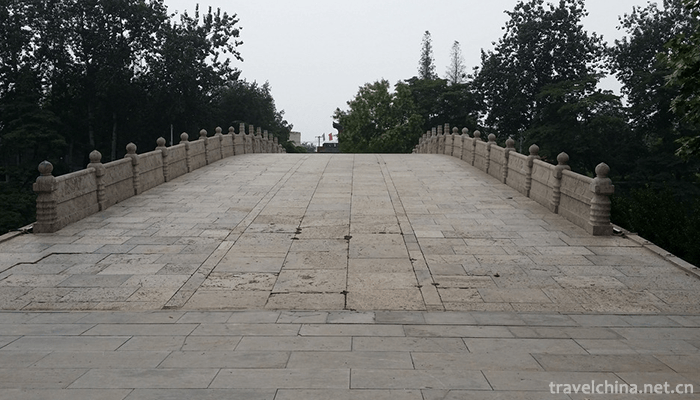
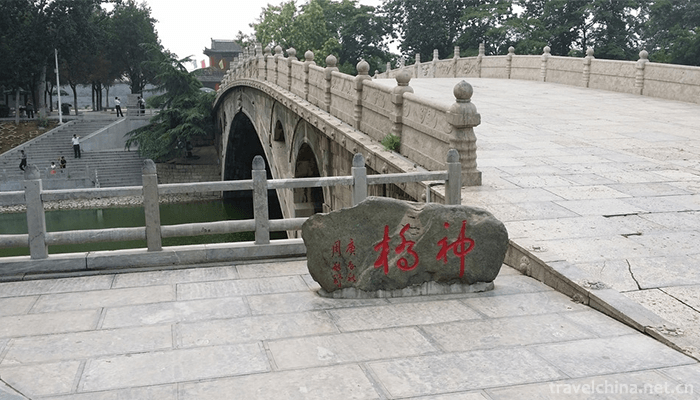
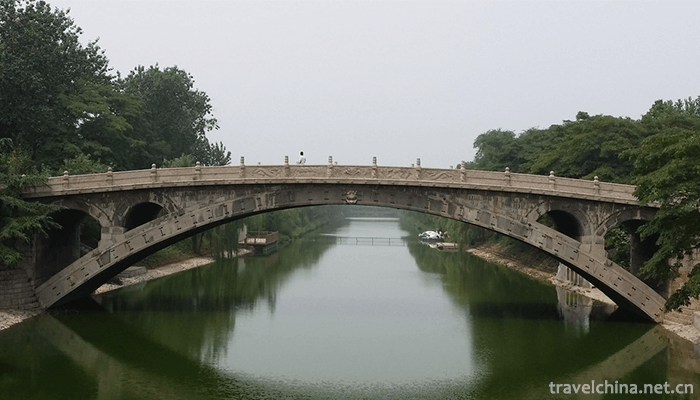
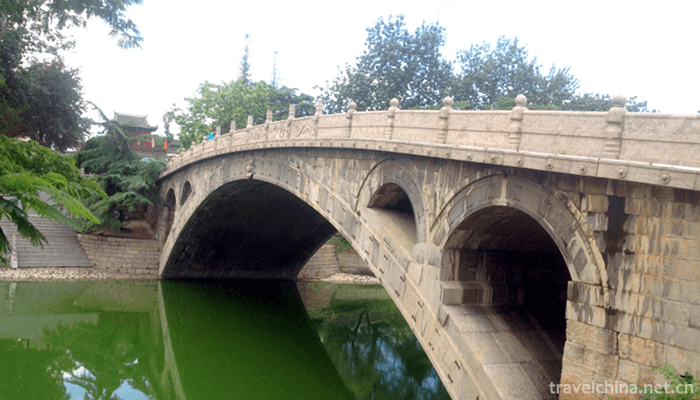
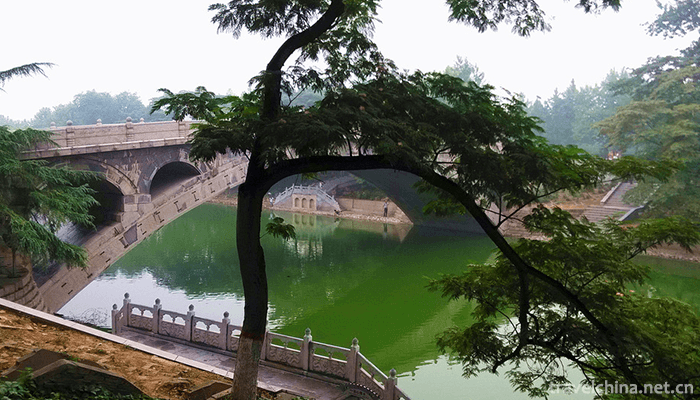
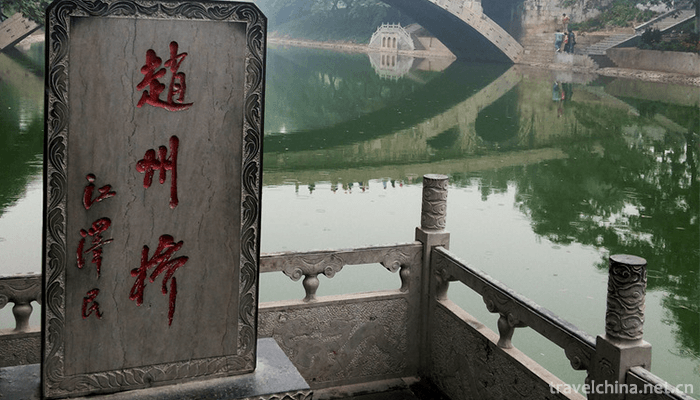
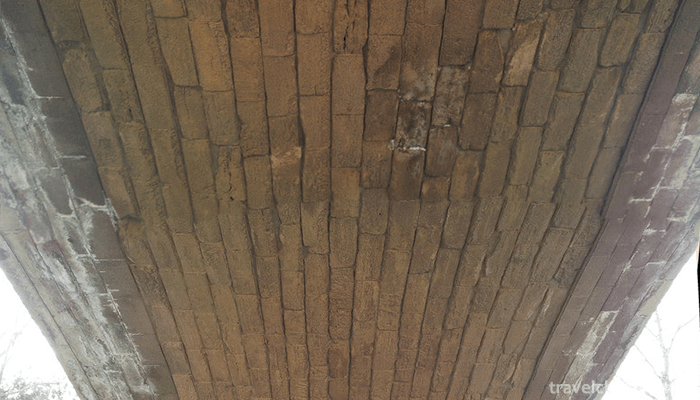
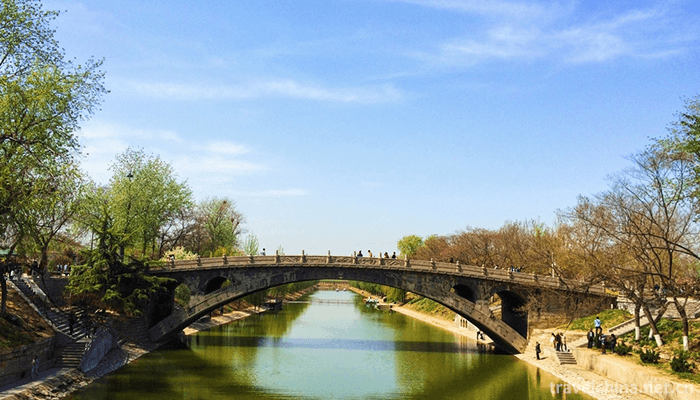




-
1.Tea horse ancient road
Tea-horse ancient road refers to the folk international trade
Time 2018-10-17 -
2.wunv mountain city
Wunu Mountain City is a national key cultural relic protection unit. It was built by Zhu Meng, the ancestor of Koguryo. The three gates of the city are narrow at the bottom of the wall
Time 2018-12-22 -
3.Huhu Water Eco Scenic Spot
Located in the southwestern edge of Pingshan County, Hebei Province, the old revolutionary area, the Biaoshui Eco-Scenic Spot has a tourist area of 11.5 square kilometers, an altitude of 800-1100 mete
Time 2019-01-12 -
4.Old Stork River Drifting
Xixia Guanhe Drifting Scenic Area is a national AAAA-level tourist attraction and a part of Funiushan World Geopark in Nanyang, China. Xixia County, Nanyang City
Time 2019-01-29 -
5.Bouyei Pange
Bouyei Pange is a traditional folk song of the Bouyei nationality. It is a folk literary work created and sung in the original Bouyei language. Bouyei Pange is popular in Buyi villages
Time 2019-04-04 -
6.Four Scenic Car Race
Duyuan Sijing Car Race is a folk activity in Pingshun County, Shanxi Province. In May 2011, Pingshun County, Shanxi Province declared the "Four Scenic Car Race
Time 2019-04-28 -
7.Miao Jia Li
Jiali, Miao is called "jaxlil". In the context of Miao language, "Jiali" is a synthesis of the semantics of "philosophy", "truth", "reason" and "
Time 2019-06-05 -
8.Eagle Claw
Eagle Claw Turn Boxing is a new type of Chinese traditional boxing, which is derived from the Eight Flash Turn. It is also a famous Chinese national master, Mr. Chen Zizheng (1878-1933) (from Li Linzh
Time 2019-07-14 -
9.Fobao ancient town
Fubao ancient town is an ancient town with a long history in Hejiang County, Sichuan Province, 42 km away from Hejiang County, Sichuan Province. It is a historical town, a famous cultural town, a tourism town, and an important business town in the junction of Sichuan, Guizhou and Chongqing. It was built in the late yuan and early Ming Dynasty, more than 600 years ago, it is named Fobao, and it is the gateway of national Fobao forest park.
Time 2020-10-16 -
10.Chongzhou jiulonggou scenic spot
Chongzhou jiulonggou scenic spot is located in Sanlang Town, Chongzhou City, with an area of more than 170 square kilometers and 76 kilometers away from Chengdu City. Jiulonggou is known as "Dragon Palace on earth".
Time 2020-11-05 -
11.Administrative division of Panzhihua
Panzhihua City has 5 county-level administrative divisions (Municipal District 3, county 2) and 49 township level administrative divisions (street 11, town 23, township 15). It covers an area of 7440 square kilometers and has a population of 1.12 million. Panzhihua Municipal People's government is located at No. 2, bingcaogang street, East District.
Time 2020-12-14 -
12.Leshan scenic spot
As of 2018, Leshan City has 3 world-class heritages, 10 national key cultural relics protection units, 4 national intangible cultural heritages, 3 national scenic spots, 2 nature reserves and wetland parks, 3 National Forest Parks, 1 National Geological Park and 1 Mining
Time 2020-12-17